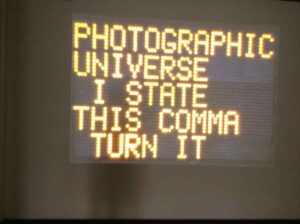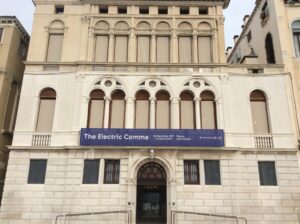
Nobel Prize winner Iosif Brodsky of Venice , “This city improves the appearance of time, embellishes the future and reveals in its palaces the most beautiful design that time has left on earth” (Watermark or Fondamenta degli incurabili in Italian). But, if the beauty of its buildings is in some ways unsustainable for the Venetians, modern architects are responsible for resizing it, says Tiziano Scarpa ironically, in his witty guide, ‘Venice is a Fish’.
Without a shadow of a doubt, it can be said that with the meticulous restoration work of the Palazzo delle Zattere, home of the V-A-C Foundation, the antique and contemporary parts have blended together very well. The Palace, built around 1850, stands on four levels, half used for exhibitions and the other half for offices and apartments; studios for young artists.
The foundation, created in Moscow in 2009 by Leonid Mikhelson and Teresa Iarocci Mavica (Director), is committed to the development of contemporary art. In May 2017 the Venetian offices opened, intended not only for exhibitions, but also for the accommodation of emerging artists. The current exhibition The Electric Comma, extended to April 2018, is a collective exhibit that questions changes in language, perception and understanding in the exchanges between human and artificial intelligence.
Venice is increasingly the go-to city for contemporary art, just think of the art galleries (Contini in first place), cultural initiatives, exhibitions and of course the Biennale.
“The continuous mixture between the old and the new, which echoes between water and land, is the salt of what you see”, writes the art historian Angela Vettese in her beautiful book ‘Venezia vive: Dal presente al futuro e viceversa’ (‘Venezia lives: from the present to the future and vice versa’). This mix, which alternates marvelous buildings from the golden age of the city with illuminated interventions by well-known archi-stars is typical of Venetian politics, of the present but also of the past, when the Serenissima welcomed the most heterogeneous trends, customs, and styles and made them their own.

The Palazzo delle Zattere is located in the Dorsoduro district (at the time of the Doges, Venice was divided into six districts, three on the right side of the Grand Canal, and three on the left side, also in order to be able to collect taxes more easily and rationally). The area, once neglected because considered peripheral, has recently acquired great vitality thanks to the offices of foundations, artist studios and associations focused on contemporary art. From San Basilio to Punta della Dogana, there is a succession of workshops, ex-warehouses, exhibition venues from the Vedova Foundation to the Pinault Collection; one can enter narrow or dizzyingly large spaces (like the former salt warehouses).
The Vedova Foundation, realised by Renzo Piano, is open to artists from all over the world, for a dialectical confrontation with the works of the “master of the house”. Emilio Vedova deeply loved this part of Venice, which wedges itself in a world of water, where commercial exchanges took place, rafts and boats of the salt loaders sailed. The artist felt the need to document human suffering and fatigue with his painting made of lights, of liquid transparencies like the water that surrounds his studio. After World War II, it was the artist himself who saved the Magazzini del Sale (where the exhibition space is located) from the decision to tear them down. In the immense space of the former salt deposits, the Master’s works are exhibited in special metal structures.
Francois Pinault, one of the greatest French collectors of contemporary art, in 2007 won the competition held by the city of Venice for the restoration of the so-called “customs house”, a 15th century building for commercial activities on the western tip of Dorsoduro. After 14 months of work, entrusted to the Japanese architect Tadao Ando, the exhibition center of contemporary art opened that hosts major exhibitions, of which the latest one was dedicated to Damien Hirst.
If Venice on one hand “dies” due to the suffocating number of tourists and the abandonment of its historical centre by the natives, on the other hand it “lives”, thanks to a continuous artistic and cultural renewal.
Liviana Martin
Liviana Martin lives and works in Milan, Italy.
volume 32 no 5 May / June 2018 pp 28-29

Hi Liviana,
Who are some of the emerging artists who have studios in the V-A-C Foundation? Is there possibly an url to see their work?
Sorry, I can’t help you about your question.
Anyway, the artists of “The electric comma” are: Erick Beltran, Alighiero Boetti, Mircea Cantor, Nicolas Consuegra, Anthony Discenza, Shannon Ebner, Valentin Fetisov, Fabien Giraud and Raphael Siboni, Piero Golia, Wade Guyton, Jacqueline Humphries, Daniel Keller, Daria Martin, Pedro Marques, Jonathan Monk, Trevor Paglen, Brigitte Riley, Andrey Shental, Dayanita Singh, Cheyney Thompson, Urban Fauna Lab.